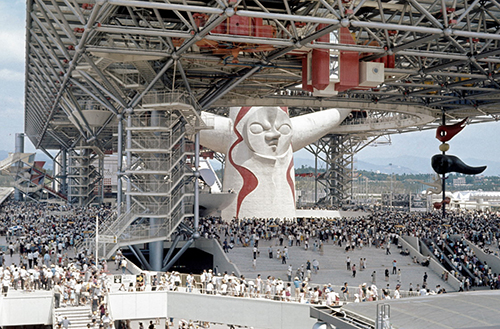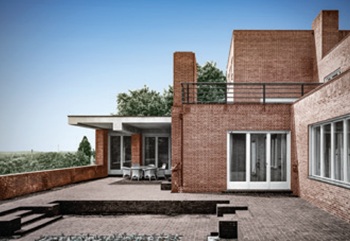Megastructure
The term ‘megastructure’ was applied to a range of futurist proposals and experiments in architecture and design during the early 1960s. The main premise of a megastructure was that a single building or structure could be used as a frame to which infrastructure, utilities and additional units could be interconnected and expanded upon, almost as a self-contained ‘city’.
The term came to popular attention in Reyner Banham’s 1976 book ‘Megastructures: Urban Futures of the Recent Past’ and was seen as an architectural response from the likes of design group Archigram and Buckminster Fuller to the developing awareness of issues such as urban densification and overpopulation.
According to Douglas Murphy in ‘Last Futures: Nature, Technology and the End of Architecture’:
‘…megastructure also referred to an architectural aesthetic – massive, disparate structures combining strict artificial forms with an organic growth of spaces within. It was a serious attempt at developing the ongoing practice of addressing large urban problems through planning whilst simultaneously incorporating the rapidly changing lifestyles of the post-war era.’
Despite belonging more to theory than actual projects, megastructures had to conform to a number of criteria:
- Capable of extension or reduction after initial construction.
- Modular.
- Built from repeating components.
- A structural framework capable of having smaller elements ‘plugged’ into it.
- A more durable initial structure than the subsequent ‘plugged-in’ elements.
Several examples of megastructures were exhibited at events such as Expo 67 and Expo 70. These took the form of giant space frames such as; Buckminster Fuller’s geodesic domes, Kenzo Tange’s Expo 1970 Theme Pavilion (see top image), and modular units such as the Japanese Metabolist movement.
During the 1970s, megastructure designs were influenced by the environmental movement and the American ‘counter-culture’, and adopted forms that were intended to be ‘floating habitats’. Examples included Buckminster Fuller’s design for Triton City (a floating ziggurat housing block with plug-in units); Kenzo Tange’s Tokyo Bay project; and Frei Otto’s ‘Arctic City’ proposal for a large envelope structure 2 km across, under which a city could be constructed that would be sheltered from harsh Arctic conditions.
[edit] Related articles on Designing Buildings Wiki
- Archigram.
- Architectural styles.
- Blobitecture.
- Buckminster Fuller.
- Chernobyl New Safe Confinement.
- Constructivist architecture.
- Frei Otto.
- Geodesic dome.
- Habitat 67.
- High-rise building.
- Hyperbolic paraboloid.
- Last Futures: Nature, Technology and the End of Architecture.
- Long span roof.
- Megacity.
- Megatall.
- Metabolism.
- Monument and context.
- Nakagin Capsule Tower.
- New York Horizon.
- Norfolk Terrace and Suffolk Terrace - ‘the Ziggurats’.
- Shell roof.
- Skyscraper.
- Speculative architecture.
- Supertall.
- The development of structural membranes.
- Types of building.
[edit] External references
- ‘Last Futures: Nature, Technology and the End of Architecture’, MURPHY, D., Verso (2016)
Featured articles and news
CIOB Construction Manager of the Year 2025
Just one of the winners at the CIOB Awards 2025.
Call for independent National Grenfell oversight mechanism
MHCLG share findings of Building Safety Inquiry in letter to Secretary of State and Minister for Building Safety.
The Architectural Technology Awards
AT Awards now open for this the sixth decade of CIAT.
50th Golden anniversary ECA Edmundson awards
Deadline for submissions Friday 30 May 2025.
The benefits of precast, off-site foundation systems
Top ten benefits of this notable innovation.
Encouraging individuals to take action saving water at home, work, and in their communities.
Takes a community to support mental health and wellbeing
The why of becoming a Mental Health Instructor explained.
Mental health awareness week 13-18 May
The theme is communities, they can provide a sense of belonging, safety, support in hard times, and a sense purpose.
Mental health support on the rise but workers still struggling
CIOB Understanding Mental Health in the Built Environment 2025 shows.
Design and construction material libraries
Material, sample, product or detail libraries a key component of any architectural design practice.
Construction Products Reform Green Paper and Consultation
Still time to respond as consultation closes on 21 May 2025.
Resilient façade systems for smog reduction in Shanghai
A technical approach using computer simulation and analysis of solar radiation, wind patterns, and ventilation.
Digital technology, transformation and cybersecurity
Supporting SMEs through Digitalisation in Construction.
Villa Wolf in Gubin, history and reconstruction. Book review.
Construction contract awards down one billion pounds
Decline over the past two months compared to the same period last year, follows the positive start to the year.
Editor's broadbrush view on forms of electrical heating in context.
The pace of heating change; BSRIA market intelligence
Electric Dreams, Boiler Realities.
New President of ECA announced
Ruth Devine MBE becomes the 112th President of the Electrical Contractors Association.

























